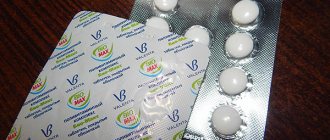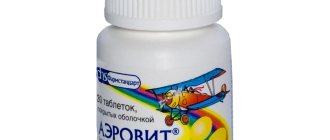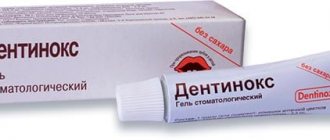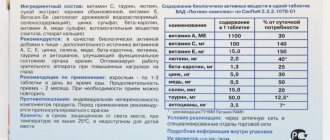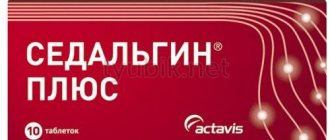Pharmacological properties
The effect of the drug is due to the vitamins that are included in its composition.
Octothiamine (a combination of vitamin B1 and α-lipoic acid) takes an active part in the metabolism of carbohydrates and fats and is necessary for the synthesis of nucleic acids. Potentiates the effect of acetylcholine, which takes part in the transmission of nerve impulses. Plays an important role in regulating the functions of the muscular system and the autonomic nervous system. Improves tissue respiration and oxygen supply to skin cells.
Riboflavin (vitamin B2) is part of numerous redox enzymes. Takes part in tissue respiration and ATP synthesis, synthesis of higher fatty acids and other processes of energy supply to the cell. Shows antioxidant properties, takes part in hematopoiesis, helping to increase the level of hemoglobin and red blood cells. Improves vision, increases color perception and twilight vision.
Pyridoxine (vitamin B6) is a component necessary for the metabolism of amino acids, fats and carbohydrates, as well as for the synthesis of physiological regulators such as serotonin and histamine. Takes part in the breakdown of cholesterol, synthesis and nutrition of the myelin sheath of peripheral nerves and axons. Vitamin B6 deficiency leads to the development of neuromuscular dystrophy and seizures.
Cyanocobalamin (vitamin B12) takes part in protein, fat and carbohydrate metabolism. Prevents fatty liver degeneration. Helps reduce the level of cholesterol in the blood and remove it from the blood vessels. By stimulating protein synthesis, it normalizes the processes of growth and development. Regulates hematopoietic processes. By increasing the phagocytic activity of leukocytes and activating the activity of the reticuloendothelial system, it enhances the body’s immunological defense.
The components of the Neurovitan complex are absorbed in the small intestine, bind to blood plasma proteins, and are distributed in all tissues. They undergo biotransformation in the body and are excreted mainly in the urine (both unchanged and in the form of metabolites).
Neurovitan instructions for use
Pharmacological action Balanced complex of B vitamins. The effect of the drug is due to the effects of the vitamins that are part of it. Vitamin B1 (thiamine) is an important part of the energy metabolism of nerve fibers in a living organism, as a coenzyme takes part in carbohydrate metabolism, and is necessary for the normal functioning of the nervous system. Octothiamine (a combined substance of vitamin B1 and thioctic acid) has a prolonged action, higher acid resistance, absorption and effectiveness compared to thiamine hydrochloride. Vitamin B2 (riboflavin) is one of the main components of carbohydrate, fat and protein metabolism and is necessary for the synthesis of hemoglobin. Vitamin B6 (pyridoxine) is involved in protein metabolism and the synthesis of neurotransmitters. Improves liver and nerve function. Vitamin B12 (cyanocobalamin) is involved in nucleotide synthesis, blood formation, myelin synthesis, development of epithelial cells and body growth. Neurovitan is absorbed along the entire length of the small intestine, intertwined with plasma proteins, and penetrates all tissues. The half-life is 1.4 hours, it is biotransformable in the body and excreted in the urine. Indications for use Neurovitan as a therapeutic complex of B vitamins is used in the treatment of diseases: - nervous system - neuritis, - neuralgia of various origins, - diabetic neuropathies, - neuralgia of various origins, - diabetic neuropathies, - paresthesias, - peripheral paralysis, - lumbago; - liver - cirrhosis, - hepatitis; - gynecological - gestosis in the early and late trimesters of pregnancy, - with symptomatic therapy in conservative and surgical gynecology, - hypo- and avitaminosis in pregnant women and during lactation in women. Neurovitan is used for diseases of the cardiovascular system, deficiency anemias of various origins, immunodeficiency states, osteochondrosis, arthralgia, radiation sickness, anemia, dermatitis, focal baldness. Neurovitan is indicated for people leading an active lifestyle, with an unbalanced diet, alcohol abuse, and smoking.
Directions for use : Use orally. Adults are prescribed 1 to 4 tablets per day. The course of treatment is 2-4 weeks. Pregnant women are prescribed 1 tablet per day. The course of treatment is 2-4 weeks. In the postpartum period, lactation period - from 1 to 2 tablets per day. The course of treatment is 2-4 weeks. Children 1-3 years old are prescribed 1/4-1/2 tablets once a day. Children 3-7 years old are prescribed 1 tablet per day. The course of treatment is 2-4 weeks. Children 8-14 years old are prescribed 1-3 tablets per day. The course of treatment is 2-4 weeks.
Side effects Allergic reactions in the form of dermatitis are possible if you are allergic to B vitamins.
Contraindications Contraindicated in case of hypersensitivity to the elements of the drug. During treatment with Neurovitan, it is prohibited to drink alcohol. When taking Neurovitan simultaneously with levodopa, the effect of the latter is reduced.
Release form: 10 tablets in blisters, 3 blisters in a cardboard box. Dispensing rules: Without a prescription.
Storage conditions Store at a temperature of 15 - 25 ° C, out of the reach of children. Shelf life 3 years.
Composition One film-coated tablet contains: octothiamine - 25 mg, riboflavin (vitamin B2) - 2.5 mg, pyridoxine hydrochloride - 40 mg, cyanocobalamin (vitamin B12) - 0.25 mg. Excipients: starch, microcrystalline cellulose, colloidal silicon dioxide, magnesium stearate, purified talc, gelatin, titanium dioxide, sucrose, carnauba cream, paraffin paraffin, povidone, shellac, ricin oil, FD&C red No. 3, FD&C yellow No. 6.
Pharmacological group Drugs that primarily affect tissue metabolic processes Vitamins and their analogues
Active ingredients : octothiamine, riboflavin mononucleotide, pyridoxine hydrochloride, cyanocobolamin
Side effects
Very rarely
General disorders: weakness, increased body temperature, increased sweating.
Cardiac disorders: tachycardia.
Vascular disorders: arterial hypotension/hypertension, feeling of heat.
From the immune system: allergic reactions, anaphylactic shock, angioedema, anaphylaxis, skin manifestations, including itching, rash, urticaria, hyperemia, burning.
Gastrointestinal tract: dyspeptic disorders (pain in the epigastric region, increased acidity of gastric juice, heartburn, nausea, vomiting, belching, feeling of fullness in the stomach, bloating, flatulence, diarrhea), dry mouth.
From the organ of vision: itching and burning in the eyes.
special instructions
With the introduction of vitamin B12, the clinical picture, as well as laboratory tests for funicular myelosis or pernicious anemia, may lose their specificity.
The drug contains lactose, so patients with rare hereditary forms of galactose intolerance, lactase deficiency or glucose-galactose malabsorption syndrome should not use the drug.
During treatment with Neurovitan, you should not drink alcohol. Drinking drinks containing sulfites (such as wine) increases the degradation of thiamine.
Since the drug contains vitamin B6, it should be used with caution in patients with a history of gastric and duodenal ulcers, severe renal and liver dysfunction.
Patients with neoplasms, with the exception of cases accompanied by megaloblastic anemia and vitamin B12 deficiency, should not use the drug.
The drug is not used for severe or acute forms of cardiac decompensation and angina.
Urine may turn yellow, which is completely harmless and is explained by the presence of riboflavin in the drug.
The drug is not recommended to be prescribed together with other multivitamins and microelements, since an overdose is possible.
Use during pregnancy and lactation. Vitamins B1, B6 and B12 are excreted into breast milk.
High concentrations of vitamin B6 may suppress milk production. Studies on the degree of secretion of vitamins into breast milk have not been conducted. The decision to discontinue breastfeeding or use of the drug should be made taking into account the need for the drug for the mother. If it is necessary to use the drug for this period, you should stop breastfeeding.
Children. Used in children over 3 years of age.
The ability to influence reaction speed when driving vehicles or working with other mechanisms. The drug does not affect the ability to drive vehicles or operate machinery. If dizziness is noted during treatment, you should refrain from driving vehicles and operating machinery.
Neurovit instructions for use
Description transparent red solution with virtually no visible particles. Composition One ampoule contains: Active substances: thiamine hydrochloride (vitamin B1) – 100 mg, pyridoxine hydrochloride (vitamin B6) – 100 mg, cyanocobalamin (vitamin B12) – 1 mg. Excipients: lidocaine hydrochloride, benzyl alcohol, potassium hexacyanoferrate (III), sodium hexametaphosphate, 10% sodium hydroxide solution, water for injection.
Pharmacotherapeutic group Combinations of vitamin B1 with vitamins B6 and/or B12.
ATX code A11DB
Pharmacodynamics Neurotropic B vitamins have a beneficial effect on inflammatory and degenerative diseases of the nerves and musculoskeletal system. Thiamine plays a key role in carbohydrate metabolism, as well as in the Krebs cycle with subsequent participation in the synthesis of thiamine pyrophosphate and ATP. Pyridoxine is involved in protein metabolism and partially in the metabolism of carbohydrates and fats. The physiological function of both vitamins is to potentiate each other’s action, manifested in a positive effect on the nervous and neuromuscular systems. Cyanocobalamin is involved in the synthesis of the myelin sheath, reduces pain associated with damage to the peripheral nervous system, and stimulates nucleic acid metabolism through the activation of folic acid. Lidocaine is a local anesthetic that causes all types of local anesthesia: terminal, infiltration, conduction.
Pharmacokinetics After intramuscular administration, thiamine is quickly absorbed from the injection site and enters the blood (484 ng/ml after 15 minutes on the first day of administration of a 50 mg dose) and is distributed unevenly in the body with its content in leukocytes - 15%, erythrocytes - 75% and in plasma - 10%. Due to the lack of significant reserves of the vitamin in the body, it must be supplied to the body daily. Thiamine penetrates the blood-brain and placental barriers and is found in breast milk. Thiamine is excreted in the urine in the alpha phase after 0.15 hours, in the beta phase after 1 hour and in the terminal phase within 2 days. The main metabolites are: thiaminecarboxylic acid, pyramine and some unknown metabolites. Of all the vitamins, thiamine is stored in the body in the smallest quantities. The adult human body contains about 30 mg of thiamine in the form of thiamine pyrophosphate (80%), thiamine triphosphate (10%) and the rest in the form of thiamine monophosphate. After intramuscular injection, pyridoxine is quickly absorbed into the bloodstream and distributed in the body, acting as a coenzyme after phosphorylation of the CH2OH group at the 5th position. About 80% of the vitamin binds to blood plasma proteins. Pyridoxine is distributed throughout the body, crosses the placenta and is found in breast milk, deposited in the liver and oxidized to 4-pyridoxine acid, which is excreted in the urine a maximum of 2–5 hours after absorption. The human body contains 40–150 mg of vitamin B6 and its daily elimination rate is about 1.7–3.6 mg with a replacement rate of 2.2–2.4%.
Indications for use Neurological disorders caused by a deficiency of vitamins B1, B6 and B12, which cannot be eliminated by correcting nutrition.
Method of administration and dosage In severe cases and acute pain, to quickly increase the level of the drug in the blood, one injection (2 ml) is administered deep intramuscularly. After the disappearance of the acute stage and in milder forms of the disease, 1 injection is given 2-3 times a week. Injections are administered deep intramuscularly. Intravenous administration is contraindicated. In case of accidental intravenous administration, monitoring of patients in the hospital is necessary. The drug contains lidocaine hydrochloride. Before using lidocaine hydrochloride, it is necessary to conduct a skin test for individual sensitivity, which is indicated by swelling and redness at the injection site.
Side effects From the immune system Rarely: hypersensitivity reactions, especially after repeated intramuscular injection (skin rash, urticaria, bronchospasm, anaphylactic shock). These hypersensitivity reactions have been reported after repeated administration of parenteral drugs containing vitamin B1, vitamin B12 or lidocaine. Nervous system disorders Rare: paresthesia, peripheral sensory neuropathy when using high doses (500 mg/day) of vitamin B6. From the cardiovascular system Rare: transient hypotension. Skin disorders Rare: acne. Systemic adverse reactions are usually associated with accidental injection into a vein, injection into highly perfused tissues, or through possible overdose. These include dizziness, vomiting, bradycardia, arrhythmia and seizures. Adverse reactions caused by the administration of lidocaine From the central and peripheral nervous system: dizziness, headache, weakness, restlessness, euphoria, nystagmus, loss of consciousness, drowsiness, sleep disturbances, tremor, trismus, convulsions (the risk of their development increases with hypercapnia and acidosis ), paresthesia, paralysis of the respiratory muscles, motor block, sensory impairment, respiratory paralysis (more often develops with subarachnoid anesthesia), numbness of the tongue and lips (when used in dentistry). From the cardiovascular system: when used in high doses - decreased blood pressure, bradycardia; when administered with a vasoconstrictor - tachycardia, cardiac conduction slowing, transverse heart block, collapse, arterial hypertension, peripheral vasodilation, chest pain, arrhythmias, heart block, cardiac arrest. From the respiratory system: respiratory depression, respiratory arrest, shortness of breath. From the gastrointestinal tract: nausea, vomiting. Allergic reactions: skin rash, urticaria, skin itching, angioedema, generalized exfoliative dermatitis, anaphylactoid reactions, conjunctivitis, rhinitis. Local reactions: a slight burning sensation that disappears with the development of the anesthetic effect. Others: hypothermia, sensations of heat, cold, or numbness in the extremities. When used in high doses - tinnitus, agitation.
Contraindications Hypersensitivity to vitamins B1, B6, B12. Hypersensitivity to local anesthetics with an amide structure. Hypersensitivity to the components of the drug, as well as to other amide local anesthetic drugs; indications in the anamnesis of epileptiform seizures associated with the administration of lidocaine hydrochloride; AV blockade of II and III degrees, sick sinus syndrome, Wolff-Parkinson-White syndrome, Adams-Stokes syndrome, severe forms of heart failure (II – III degree), severe arterial hypotension, bradycardia, cardiogenic shock, complete transverse heart block; myasthenia gravis; hypovolemia; porphyria, severe renal and/or liver failure, pregnancy, breastfeeding, age up to 12 years. Malignant tumors.
Overdose In case of overdose, systemic reactions may occur. Adverse reactions such as dizziness, bradycardia, vomiting or shock may occur. When vitamin B6 is taken in high doses (500 mg/day) for a long period (more than 5 months), peripheral sensory neuropathy may occur. Treatment is symptomatic and supportive. There is no specific antidote. Lidocaine overdose The main symptoms associated with depression of the central nervous system and cardiovascular system: general weakness, dizziness, disorientation, tonic-clonic convulsions, coma, tremor, blurred vision, atrioventricular block, asphyxia, nausea, vomiting, euphoria, psychomotor agitation, asthenia, apnea, bradycardia, decreased blood pressure, collapse. The first symptoms of overdose in healthy people occur when the concentration of lidocaine hydrochloride in the blood is more than 0.006 mg/kg, convulsions - at 0.01 mg/kg. Treatment: discontinuation of drug administration, oxygen therapy, vasoconstrictors (norepinephrine, mezaton), anticholinergics. The patient should be in a horizontal position; it is necessary to provide access to fresh air, oxygen supply and/or artificial respiration. Symptoms from the central nervous system are corrected by the use of benzodiazepines or short-acting barbiturates. To correct bradycardia and conduction disturbances, atropine (0.5 – 1.0 mg) is used; for arterial hypotension, sympathomimetics are used in combination with beta-adrenergic receptor agonists. In case of cardiac arrest, immediate resuscitation measures are indicated. It is possible to use intubation and artificial ventilation. In the acute phase of lidocaine overdose, dialysis is not effective. There is no specific antidote.
Precautions and particulars of use Use in patients with psoriasis should be justified, since vitamin B12 can aggravate skin manifestations. With long-term treatment (more than 5 months), sensory neuropathy may develop with an overdose of vitamin B6 (more than 500 mg/day). In rare cases, after repeated administration of a drug containing vitamin B1, anaphylactic shock may develop. Excipients It is recommended to use it with caution in patients with heart and liver failure, since the drug contains lidocaine. The drug is contraindicated for use in newborns, especially premature infants, since the drug contains benzyl alcohol. Before using lidocaine, it is necessary to conduct a skin test for individual sensitivity to the drug, which is indicated by swelling and redness at the injection site. When injecting into vascularized tissues, it is recommended to perform an aspiration test and administer carefully to prevent lidocaine from entering the bloodstream. Before administering lidocaine hydrochloride in high doses, it is recommended to prescribe a barbiturate. When treating the injection site with disinfectant solutions containing heavy metals, the risk of developing a local reaction in the form of pain and swelling increases. When using lidocaine, ECG monitoring is required. In case of disturbances in the activity of the sinus node, prolongation of the PQ interval, widening of the QRS, or the development of a new arrhythmia, the dose should be reduced or the drug discontinued. Use with caution and in smaller doses in patients with heart failure, arterial hypertension, incomplete atrioventricular block, intraventricular conduction disorders, impaired liver and kidney function, epilepsy, after heart surgery, with a genetic predisposition to hyperthermia, and in debilitated patients. Use with caution in elderly patients, as well as in persons with a history of arrhythmia. It is necessary to discontinue MAO inhibitors at least 10 days before therapy.
Use during pregnancy and lactation Use of the drug during pregnancy is contraindicated. If it is necessary to use the drug, breastfeeding should be discontinued. Effect on the ability to drive vehicles or potentially dangerous mechanisms After using this drug, it is not recommended to engage in activities that require rapid psychomotor reactions.
Interactions with other drugs 5-fluorouracil is a thiamine antagonist and therefore affects the effectiveness of vitamin B1. Vitamin B1 acts as an acetylcholine antagonist and increases the effect of neuromuscular blockers. The simultaneous use of the drug with drugs containing levodopa is not recommended, since vitamin B6 reduces the effectiveness of levodopa. Absorption of vitamin B12 from the gastrointestinal tract may be reduced by certain drugs, such as proton pump inhibitors, aminoglycosides, colchicine, aminosalicylic acid and its salts, phenytoin, potassium salts, primidone and phenobarbital. Chloramphenicol reduces the hematopoietic vitamin B12 response in patients with vitamin B12 deficiency who are receiving concomitant vitamin B12 therapy. Alcohol reduces the effect of vitamins. Vitamin B1 is not very stable in solutions containing sulfites. Other vitamins may become inactive in the presence of thiamine metabolites. Ascorbic acid reduces the effectiveness of cyanocobalamic acid. Thus, the above drugs are not prescribed simultaneously. Interactions caused by the content of lidocaine hydrochloride Lidocaine enhances the inhibitory effect on the respiratory center of anesthetics (hexobarbital, sodium thiopental intravenously), hypnotics and sedatives. When used simultaneously with hypnotics and sedatives, the inhibitory effect on the central nervous system may be enhanced. Ethanol enhances the inhibitory effect of lidocaine on respiratory function. When used simultaneously with beta-adrenergic blockers, a reduction in the dose of lidocaine is necessary. When used simultaneously with polymyxin B, monitoring of respiratory function is necessary. During treatment with MAO inhibitors, lidocaine should not be used parenterally, as this increases the risk of developing arterial hypotension. When used simultaneously with procainamide, hallucinations are possible. Lidocaine may enhance the effect of drugs that block neuromuscular transmission, since the latter reduce the conduction of nerve impulses. In case of intoxication with cardiac glycosides, lidocaine can increase the severity of AV blockade. Lidocaine weakens the cardiotonic effect of cardiac glycosides. The drug is prescribed with caution in combination with: beta-adrenergic receptor blockers (the metabolism of lidocaine in the liver slows down, the effects of lidocaine increase (including toxic ones) and the risk of developing bradycardia and arterial hypotension increases); curare-like drugs (possible deepening of muscle relaxation (to the point of paralysis of the respiratory muscles)); norepinephrine, mexiletine (the toxicity of lidocaine increases, the clearance of lidocaine decreases); isadrine, glucagon (increases lidocaine clearance); midazolam (increases the concentration of lidocaine in the blood plasma); barbiturates, including phenobarbital (possibly accelerated metabolism of lidocaine in the liver, decreased concentration in the blood); antiarrhythmic drugs (amiodarone, verapamil, quinidine, ajmaline, disopyramide, propafenone), hydantoin derivatives (the cardiodepressive effect is enhanced, simultaneous use with amiodarone can lead to the development of seizures); novocaine, novocainamide (possible stimulation of the central nervous system and the occurrence of hallucinations); morphine (the analgesic effect of morphine is enhanced); prenylamine (increases the risk of developing ventricular arrhythmia of the “pirouette” type); rifampicin (possibly reducing the concentration of lidocaine in the blood); phenytoin (increases the cardiodepressive effect of lidocaine); vasoconstrictors (epinephrine, methoxamine, phenylephrine) (help slow down the absorption of lidocaine and prolong its action).
Conditions and shelf life Store at a temperature not exceeding 25°C. Keep out of the reach of children. Shelf life: 2 years.
Packaging 2 ml of solution for intramuscular administration in dark glass ampoules with a white break ring. 5 or 10 ampoules in a cell package. One or two blister packs No. 5 or one blister pack No. 10 together with instructions for use in a cardboard pack.
Interactions
The action of thiamine is inactivated by fluorouracil, since the latter competitively inhibits the phosphorylation of thiamine to thiamine pyrophosphate.
Antacids reduce the absorption of thiamine. Loop diuretics, such as furosemide, which inhibit tubular reabsorption, may increase thiamine excretion and thus reduce thiamine levels when used long-term.
Concomitant use with levodopa is contraindicated, since vitamin B6 may reduce the severity of the antiparkinsonian effect of levodopa.
Concomitant use with pyridoxine antagonists (for example, isoniazid, hydralazine, penicillamine or cycloserine), oral contraceptives may increase the need for vitamin B6.
Overdose
Vitamin B1: has a wide therapeutic range. in very high doses (10 g) it exhibits a curare-like effect, suppressing the conduction of nerve impulses.
Vitamin B6: has very low toxicity. Long-term use (more than 6-12 months) in doses of 50 mg of vitamin B6 daily can lead to peripheral sensory neuropathy, nervous agitation, malaise, dizziness, and headache. Excessive use of vitamin B6 in doses of 1 g/day for several months can lead to neurotoxic effects. Neuropathies with ataxia and sensitivity disorders, cerebral spasms with changes in the EEG, as well as in some cases, hypochromic anemia and seborrheic dermatitis were detected after taking a dose of 2 g/day.
Vitamin B12: after parenteral administration (in rare cases, after oral administration) in doses higher than recommended, allergic reactions, eczematous skin disorders and a benign form of acne were observed.
With long-term use of high doses of vitamin B12, disturbances in the activity of liver enzymes, pain in the heart, and hypercoagulation are possible.
Note!
Description of the drug Neurovitan table. p/o No. 30 on this page is a simplified author’s version of the apteka911 website, created on the basis of the instructions for use.
Before purchasing or using the drug, you should consult your doctor and read the manufacturer's original instructions (attached to each package of the drug). Information about the drug is provided for informational purposes only and should not be used as a guide to self-medication. Only a doctor can decide to prescribe the drug, as well as determine the dose and methods of its use.
Neurovitan
Name: Neurovitan Pharmacological action: A balanced complex of B vitamins. The effect of the drug is due to the effects of the vitamins that are part of it. Vitamin B1 (thiamine) is an important part of the energy metabolism of nerve fibers in a living organism, as a coenzyme takes part in carbohydrate metabolism, and is necessary for the normal functioning of the nervous system. Octothiamine (a combined substance of vitamin B1 and thioctic acid) has a prolonged action, higher acid resistance, absorption and effectiveness compared to thiamine hydrochloride. Vitamin B2 (riboflavin) is one of the main components of carbohydrate, fat and protein metabolism and is necessary for the synthesis of hemoglobin. Vitamin B6 (pyridoxine) is involved in protein metabolism and the synthesis of neurotransmitters. Improves liver and nerve function. Vitamin B12 (cyanocobalamin) is involved in nucleotide synthesis, blood formation, myelin synthesis, development of epithelial cells and body growth. Neurovitan is absorbed along the entire length of the small intestine, intertwined with plasma proteins, and penetrates all tissues. The half-life is 1.4 hours, it is biotransformable in the body and excreted in the urine.
Indications for use: Neurovitan as a therapeutic complex of B vitamins is used in the treatment of diseases: - nervous system - neuritis, - neuralgia of various origins, - diabetic neuropathies, - neuralgia of various origins, - diabetic neuropathies, - paresthesias, - peripheral paralysis, - lumbago; - liver - cirrhosis, - hepatitis; - gynecological - gestosis in the early and late trimesters of pregnancy, - with symptomatic therapy in conservative and surgical gynecology, - hypo- and avitaminosis in pregnant women and during lactation in women. Neurovitan is used for diseases of the cardiovascular system, deficiency anemias of various origins, immunodeficiency states, osteochondrosis, arthralgia, radiation sickness, anemia, dermatitis, focal baldness. Neurovitan is indicated for people leading an active lifestyle, with an unbalanced diet, alcohol abuse, and smoking.
Directions for use: Apply orally. Adults are prescribed 1 to 4 tablets per day. The course of treatment is 2-4 weeks. Pregnant women are prescribed 1 tablet per day. The course of treatment is 2-4 weeks. In the postpartum period, lactation period - from 1 to 2 tablets per day. The course of treatment is 2-4 weeks. Children 1-3 years old are prescribed 1/4-1/2 tablets once a day. Children 3-7 years old are prescribed 1 tablet per day. The course of treatment is 2-4 weeks. Children 8-14 years old are prescribed 1-3 tablets per day. The course of treatment is 2-4 weeks.
Side effects: Allergic reactions in the form of dermatitis are possible if you are allergic to B vitamins.
Contraindications: Contraindicated in case of hypersensitivity to the elements of the drug. During treatment with Neurovitan, it is prohibited to drink alcohol. When taking Neurovitan simultaneously with levodopa, the effect of the latter is reduced.
Release form: 10 tablets in blisters, 3 blisters in a cardboard box. Dispensing rules: Without a prescription.
Storage conditions: Store at a temperature of 15 - 25 ° C, out of the reach of children. Shelf life 3 years.
Composition: One film-coated tablet contains: octothiamine - 25 mg, riboflavin (vitamin B2) - 2.5 mg, pyridoxine hydrochloride - 40 mg, cyanocobalamin (vitamin B12) - 0.25 mg. Excipients: starch, microcrystalline cellulose, colloidal silicon dioxide, magnesium stearate, purified talc, gelatin, titanium dioxide, sucrose, carnauba cream, paraffin paraffin, povidone, shellac, ricin oil, FD&C red No. 3, FD&C yellow No. 6.
Additionally: The first “big” multivitamins were developed by order of NASA specifically for the Apollo program. After the first space flights, it turned out that in zero gravity, when the human heart is working in heart attack mode, the need for vitamins increases tens and hundreds of times.
Neurovitan is a relatively new drug not only in Ukraine, but throughout the world, it contains a complex of B vitamins in large therapeutic doses, and is an original drug. It is synthesized (Japan) and has international quality certificates of FDA, GMP, MCI. Neurovitan is used for both therapeutic and prophylactic purposes. The B vitamin complex includes vitamins B1, B2, B6 and B12 in therapeutic doses. An interesting fact is that vitamin B1 is in the form of octothiamine - a combined substance of thiamine (vitamin B1) and lipoic acid and has their properties. Octothiamine is also an original development of the company, which has no analogues throughout the world. A combination of therapeutic doses of vitamins B1, B2, B6 and B12 has been developed, exceeding preventive doses by 12.5; 1.5; 20; 5 times, respectively. One Neurovitan tablet contains: octothiamine (vitamin B1 + lipoic acid) - 25 mg; vitamin B2 (riboflavin) - 2.5 mg; vitamin B6 (pyridoxine) - 40 mg; vitamin B12 (cyanocobalamin) - 250 mcg. Due to its unique form (each vitamin is in a microcapsule), all components included in Neurovitan do not interact and are well absorbed. Moreover, vitamins B1, B2, B6 and B12 in combination have a more pronounced therapeutic effect than when used separately. Vitamin B1 (thiamine hydrochloride) is part of enzyme systems that regulate many important functions of the body, the exchange of amino acids, which ensures the use of carbohydrates by cells. Due to enzyme deficiency, carbohydrates in the body tissues are not completely burned, and toxic products accumulate, which is the cause of beriberi disease. Its deficiency sometimes occurs in alcoholism as a result of poor nutrition. The recommended daily dose of thiamine for adults is 1 to 1.5 mg. For medicinal purposes, thiamine is prescribed in much larger doses. Vitamin B1 has a positive effect on the functions of the muscular and nervous systems. It is necessary for the normal functioning of the central and peripheral nervous system. The vitamin is prescribed for neuritis, radiculitis, diseases of the gastrointestinal tract and liver, as well as for dermatoses of neurogenic origin, itching. An increased need for vitamin B1 is observed in case of poisoning with nicotine, heavy metals, and in stressful situations. Lipoic acid is part of two key enzyme complexes involved in glucose metabolism and is a universal antioxidant. Octothiamine (a combined substance of vitamin B1 and lipoic acid) has a prolonged action, higher acid resistance, absorption and effectiveness compared to thiamine hydrochloride. Vitamin B2 (riboflavin) affects the growth and reproduction of cells, is part of enzymes that play a significant role in oxidation reactions in all human tissues, as well as regulating the metabolism of carbohydrates, proteins, and fats. Riboflavin is important for maintaining normal eye function and is part of visual purple, protecting the retina from the harmful effects of ultraviolet rays. For medicinal purposes, riboflavin is used for hypo- and vitamin B2 deficiency, eye disease, long-term non-healing wounds and ulcers, radiation sickness, intestinal dysfunction and other diseases. Vitamin B6 is necessary for the functioning of the body, is involved in the metabolism of amino acids and fatty acids, and is prescribed to patients who have been taking antibiotics for a long time. Vitamin deficiency leads to disorders of the nervous system, blood, blood vessels, and contributes to the development of skin diseases. Vitamin B12 affects blood formation, activates blood clotting processes, participates in the synthesis of various amino acids, nucleic acids, myelin, activates carbohydrate and fat metabolism, and has a beneficial effect on the functions of the liver, nervous and digestive systems. With insufficient consumption of vitamin B12, anemia develops, the activity of the nervous system is disrupted, weakness, dizziness, shortness of breath appear, and appetite decreases.
Clinical effectiveness.
Studies on the use of Neurovitan for neurological disorders (both central and peripheral nervous systems), diseases of the musculoskeletal system, skin and hair, liver dysfunction were carried out in research centers not only in the USA and Japan, but also in Ukraine, where high the effectiveness and safety of its use, there were no side effects. Neurovitan is not inferior in its effectiveness and even surpasses traditional parenteral forms of B vitamins. Thanks to the rational combination of Neurovitan's constituent vitamins, which complement each other, the most pronounced therapeutic effect is manifested. Long-term use of Neurovitan leads to complete cure of nervous and muscle disorders, elimination of deficiency of B vitamins. In this case, the clinical effect is achieved in 100% of cases.
More detailed information on this drug can be found in this literature:
1. Clinical experience of NEUROVITAN in orthopedics. Department of Orthopedic Faculty of Medicine (Director: Prof. Eishi Kondo) Kyoto University, Kyoto, Japan 2. Fundamental Experiment and Clinical Application of TATD. Professor Tatsuo Abe, MD, Kohei Hoshina, MD Basic research and clinical use of TATD. Abe Clinic of Internal Medicine, Toho University, School of Medicine, Japan // Japan medical news No. 24, Mar., 1963 & No.26, Aug., 1963 Clinical Experience with Neurovitan in Orthopedics. 2. Clinical Experience Using Neurovitan in the Orthopedic Field. T. Tsuzura Experience of clinical use of NEUROVITAN in orthopedics. Tokyo Koseinenkin Hospital, Orthopedic Clinic//Asian medical journal Vol. 6 No. 7, July 1963, Japan. 3. Fadeenko G. D. The effectiveness of a complex vitamin preparation - NEUROVITAN / Institute of Therapy of the Academy of Medical Sciences of Ukraine, Department of Gastroenterology // Pharmacological Bulletin. 1997, no. 4, p. 44-46. 4. Fadeenko G. D. NEUROVITAN in the complex treatment of intestinal dysbiosis // Ukrainian Medical Hours. 2001, 5/25, IX-X. 5. Clinical Experience with Neurovitan. M. Nakano. Clinical effectiveness of NEUROVITAN. Department of Internal Medicine, Takaoka City Hospital, Japan.
Attention! The description of the drug " Neurovitan " on this page is a simplified and expanded version of the official instructions for use. Before purchasing or using the drug, you should consult your doctor and read the instructions approved by the manufacturer. Information about the drug is provided for informational purposes only and should not be used as a guide to self-medication. Only a doctor can decide to prescribe the drug, as well as determine the dose and methods of its use.

